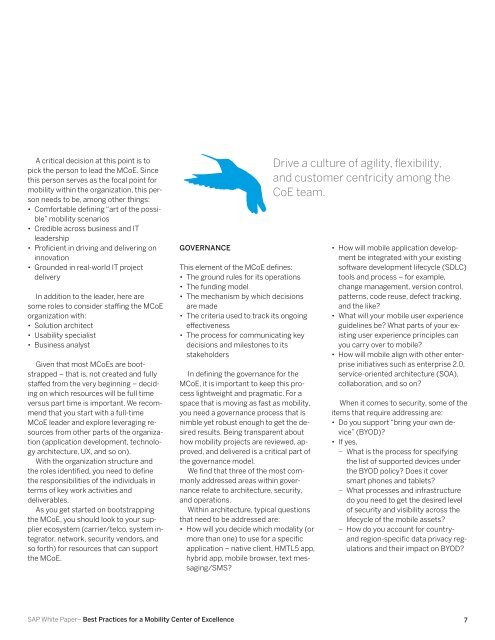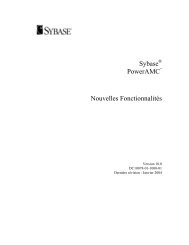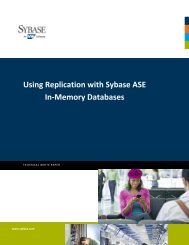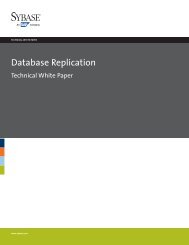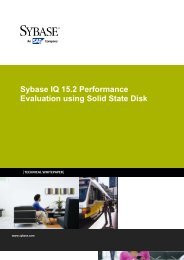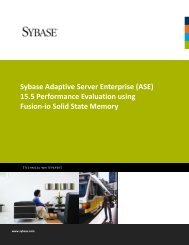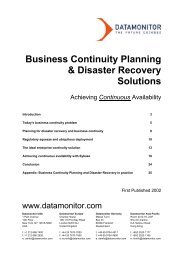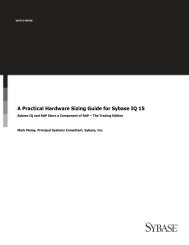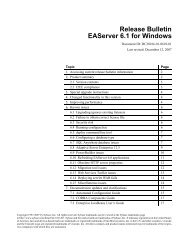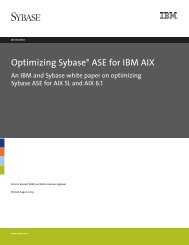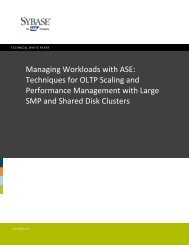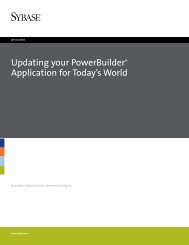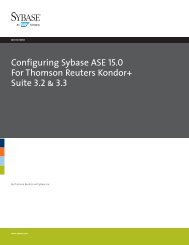Best Practices for a Mobility Center of Excellence - Sybase
Best Practices for a Mobility Center of Excellence - Sybase
Best Practices for a Mobility Center of Excellence - Sybase
You also want an ePaper? Increase the reach of your titles
YUMPU automatically turns print PDFs into web optimized ePapers that Google loves.
A critical decision at this point is to<br />
pick the person to lead the MCoE. Since<br />
this person serves as the focal point <strong>for</strong><br />
mobility within the organization, this person<br />
needs to be, among other things:<br />
• Com<strong>for</strong>table defi ning “art <strong>of</strong> the possible”<br />
mobility scenarios<br />
• Credible across business and IT<br />
leadership<br />
• Pr<strong>of</strong>i cient in driving and delivering on<br />
innovation<br />
• Grounded in real-world IT project<br />
delivery<br />
In addition to the leader, here are<br />
some roles to consider staffi ng the MCoE<br />
organization with:<br />
• Solution architect<br />
• Usability specialist<br />
• Business analyst<br />
Given that most MCoEs are bootstrapped<br />
– that is, not created and fully<br />
staff ed from the very beginning – deciding<br />
on which resources will be full time<br />
versus part time is important. We recommend<br />
that you start with a full-time<br />
MCoE leader and explore leveraging resources<br />
from other parts <strong>of</strong> the organization<br />
(application development, technology<br />
architecture, UX, and so on).<br />
With the organization structure and<br />
the roles identifi ed, you need to defi ne<br />
the responsibilities <strong>of</strong> the individuals in<br />
terms <strong>of</strong> key work activities and<br />
deliverables.<br />
As you get started on bootstrapping<br />
the MCoE, you should look to your supplier<br />
ecosystem (carrier/telco, system integrator,<br />
network, security vendors, and<br />
so <strong>for</strong>th) <strong>for</strong> resources that can support<br />
the MCoE.<br />
GOVERNANCE<br />
SAP White Paper– <strong>Best</strong> <strong>Practices</strong> <strong>for</strong> a <strong>Mobility</strong> <strong>Center</strong> <strong>of</strong> <strong>Excellence</strong><br />
This element <strong>of</strong> the MCoE defi nes:<br />
• The ground rules <strong>for</strong> its operations<br />
• The funding model<br />
• The mechanism by which decisions<br />
are made<br />
• The criteria used to track its ongoing<br />
eff ectiveness<br />
• The process <strong>for</strong> communicating key<br />
decisions and milestones to its<br />
stakeholders<br />
In defi ning the governance <strong>for</strong> the<br />
MCoE, it is important to keep this process<br />
lightweight and pragmatic. For a<br />
space that is moving as fast as mobility,<br />
you need a governance process that is<br />
nimble yet robust enough to get the desired<br />
results. Being transparent about<br />
how mobility projects are reviewed, approved,<br />
and delivered is a critical part <strong>of</strong><br />
the governance model.<br />
We fi nd that three <strong>of</strong> the most commonly<br />
addressed areas within governance<br />
relate to architecture, security,<br />
and operations.<br />
Within architecture, typical questions<br />
that need to be addressed are:<br />
• How will you decide which modality (or<br />
more than one) to use <strong>for</strong> a specifi c<br />
application – native client, HMTL5 app,<br />
hybrid app, mobile browser, text messaging/SMS?<br />
Drive a culture <strong>of</strong> agility, fl exibility,<br />
and customer centricity among the<br />
CoE team.<br />
• How will mobile application development<br />
be integrated with your existing<br />
s<strong>of</strong>tware development lifecycle (SDLC)<br />
tools and process – <strong>for</strong> example,<br />
change management, version control,<br />
patterns, code reuse, defect tracking,<br />
and the like?<br />
• What will your mobile user experience<br />
guidelines be? What parts <strong>of</strong> your existing<br />
user experience principles can<br />
you carry over to mobile?<br />
• How will mobile align with other enterprise<br />
initiatives such as enterprise 2.0,<br />
service-oriented architecture (SOA),<br />
collaboration, and so on?<br />
When it comes to security, some <strong>of</strong> the<br />
items that require addressing are:<br />
• Do you support “bring your own device”<br />
(BYOD)?<br />
• If yes,<br />
– What is the process <strong>for</strong> specifying<br />
the list <strong>of</strong> supported devices under<br />
the BYOD policy? Does it cover<br />
smart phones and tablets?<br />
– What processes and infrastructure<br />
do you need to get the desired level<br />
<strong>of</strong> security and visibility across the<br />
lifecycle <strong>of</strong> the mobile assets?<br />
– How do you account <strong>for</strong> country-<br />
and region-specifi c data privacy regulations<br />
and their impact on BYOD?<br />
7


